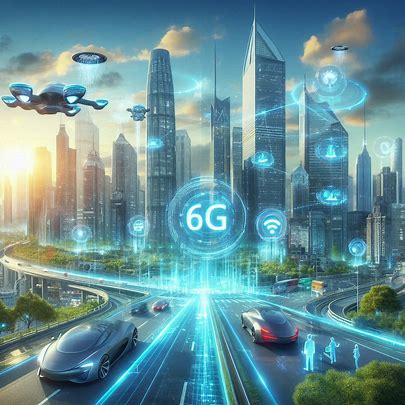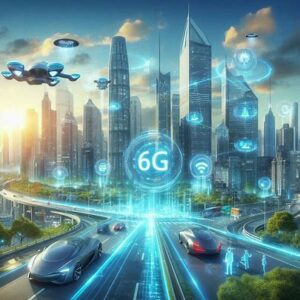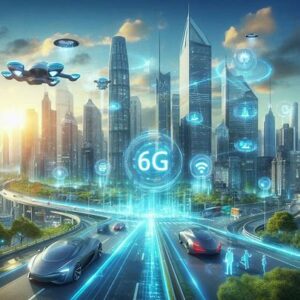
Introduction
Imagine a world where your smart glasses stream holographic video calls instantly, self-driving cars communicate flawlessly across continents, or entire cities operate with seamless, intelligent systems powered by trillions of connected devices. This is the vision of 6G networks, the next generation of wireless technology set to succeed 5G. While 5G is still rolling out globally, researchers are already laying the groundwork for 6G, promising unprecedented speeds, ultra-low latency, and transformative applications. This article explores what 6G is, how it works, its potential applications, current trends, and its role in shaping the future, all in an engaging and accessible way.
What is 6G?
6G, or sixth-generation wireless networks, is the anticipated successor to 5G, expected to launch commercially around 2030. It aims to deliver data speeds up to 1 terabit per second (Tbps)—100 times faster than 5G—latency as low as 100 microseconds, and the capacity to connect billions of devices with enhanced reliability and energy efficiency. 6G is designed to support advanced technologies like holographic communication, artificial intelligence (AI), and the Internet of Everything (IoE).
Key Features of 6G
- Extreme Speeds: 6G could enable downloading a 4K movie in milliseconds.
- Ultra-Low Latency: Near-instantaneous data transfer supports real-time applications like remote surgery or autonomous systems.
- Massive Connectivity: 6G will connect trillions of devices, from sensors to drones, in dense environments.
- Energy Efficiency: Optimized for low-power devices, reducing environmental impact.
- Intelligent Networks: AI-driven networks will self-optimize for performance and security.
For example, a 6G-enabled smart city could manage traffic, energy, and emergency services in real-time, with devices communicating seamlessly.
From breaking news to market moves — timing is everything. Learn how to trade with precision.

How 6G Works
6G builds on 5G’s foundation but introduces groundbreaking technologies to achieve its ambitious goals. Here’s a simplified overview:
- Terahertz (THz) Frequencies: 6G will use higher frequency bands (100 GHz to 3 THz), offering massive bandwidth but shorter range, requiring dense antenna networks.
- Advanced Antennas: Intelligent beamforming and massive MIMO (Multiple Input Multiple Output) will direct signals precisely, improving efficiency.
- AI Integration: AI will manage network resources, predict demand, and enhance security dynamically.
- Integrated Sensing and Communication (ISAC): 6G will combine communication with environmental sensing, enabling devices to map surroundings for applications like autonomous navigation.
- Satellite and Non-Terrestrial Networks: 6G will integrate satellites and high-altitude platforms (e.g., drones) for global coverage.
For instance, a 6G-powered holographic meeting would transmit high-resolution 3D visuals in real-time, with AI optimizing the connection to ensure clarity.
Potential Applications of 6G
While 6G is still in development, its potential applications are vast, promising to revolutionize industries and daily life.
Holographic Communication
6G’s high bandwidth could enable life-like holographic calls, where 3D avatars appear in real-time. Businesses could host virtual meetings with participants feeling physically present, while families could connect across distances immersively.
Autonomous Systems
6G’s ultra-low latency will enhance autonomous vehicles, drones, and robots. For example, self-driving cars could share real-time data with infrastructure and other vehicles globally, improving safety and coordination.
Smart Cities and IoE
6G will power the Internet of Everything, connecting not just devices but environments and humans. Smart cities could use 6G to manage energy grids, monitor air quality, and optimize public services with trillions of sensors communicating instantly.
Healthcare
6G could enable remote surgeries with haptic feedback, where surgeons control robotic arms from anywhere with no perceptible delay. Wearable sensors could monitor health in real-time, transmitting data to doctors for immediate analysis.
Extended Reality (XR)
6G will enhance virtual reality (VR), augmented reality (AR), and mixed reality (MR) for seamless experiences. For instance, XR training simulations for pilots or surgeons could feel indistinguishable from reality, powered by 6G’s speed and sensing capabilities.
Current Trends in 6G Development
As of June 2025, 6G is in the research and early standardization phase, with global efforts shaping its future. Here are key trends:
Global Research Initiatives
Countries like China, South Korea, Japan, the U.S., and the EU are investing heavily in 6G. China’s 6G test satellite, launched in 2020, is exploring THz frequencies, while the EU’s Hexa-X project is defining 6G standards for 2030 deployment.
Terahertz Frequency Exploration
Researchers are overcoming THz challenges, like signal loss over distance, using advanced materials like graphene for antennas. Testbeds, such as those at Nokia, are demonstrating THz feasibility for ultra-high-speed communication.
AI-Driven Networks
AI is central to 6G’s vision of self-optimizing networks. Machine learning models are being developed to manage spectrum allocation and predict traffic patterns, as seen in Samsung’s 6G prototypes.
Integrated Sensing and Communication
ISAC is a hallmark of 6G, enabling devices to sense environments while communicating. For example, 6G base stations could map surroundings for autonomous drones, tested in trials by Ericsson.
Sustainability Focus
6G aims to reduce energy consumption despite higher performance. Green technologies, like energy-harvesting antennas, are being explored to power 6G networks sustainably, aligning with global climate goals.
Non-Terrestrial Networks
6G will leverage low-earth-orbit (LEO) satellites and high-altitude platforms for global coverage. Companies like SpaceX and Amazon are collaborating on 6G satellite integration to connect remote areas.
Benefits of 6G
6G offers transformative advantages:
- Unprecedented Speed: Enables instant data transfers for immersive applications.
- Near-Zero Latency: Supports mission-critical systems like autonomous vehicles.
- Global Connectivity: Extends coverage to remote and underserved regions.
- Innovation Catalyst: Fuels advancements in AI, XR, and IoE, creating new industries.
- Sustainability: Energy-efficient designs reduce environmental impact.
Challenges of 6G
Despite its potential, 6G faces significant hurdles:
- Infrastructure Costs: Deploying THz antennas and satellite networks requires massive investment.
- Technical Limitations: THz signals have short ranges and are blocked by obstacles, needing innovative solutions.
- Security Risks: Connecting trillions of devices increases vulnerabilities, requiring quantum-resistant encryption.
- Regulatory Hurdles: Global spectrum allocation and standardization demand international cooperation.
- Digital Divide: Ensuring equitable access to 6G in developing regions is critical.
Addressing these requires collaboration across governments, industries, and academia.

The Future of 6G
By 2030, 6G could redefine connectivity, with profound impacts:
- Immersive Digital Worlds: Holographic and XR experiences will blur physical and virtual boundaries.
- Intelligent Ecosystems: Cities, factories, and homes will operate autonomously with 6G-powered IoE.
- Global Inclusion: Satellite-based 6G will bring connectivity to remote communities, bridging the digital divide.
- Healthcare Transformation: Real-time health monitoring and telesurgery will improve global access to care.
Continued investment in research, infrastructure, and ethical frameworks will ensure 6G’s benefits are realized responsibly.
Conclusion
6G networks are poised to revolutionize connectivity, offering speeds, reliability, and intelligence far beyond 5G. From holographic communication to autonomous systems and smart cities, 6G’s applications promise to transform how we live and work. As trends like AI integration, THz frequencies, and sustainable designs drive progress, 6G is shaping a future where technology is seamless, inclusive, and sustainable. By overcoming challenges like cost and security, 6G can connect the world in ways we’re only beginning to imagine, paving the way for a truly intelligent digital era.



